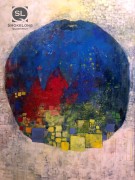In an imaginary topography, where would your woebegone place be called and where would it be?
When I was little I was told these two things quite often by people around me, including my well meaning parents.
—a girl should never put herself first
—a girl shouldn’t get too smart or no man would want her
A transfer of moral value that can have a legacy of consequences, they are also the two things I struggle the most with, the psychological underside of the first is guilt, the second is a vacillation between perpetual diffidence or deception (But I’m not alone in this. How many women we know hide their intelligence as social or survival strategies on the corporate hierarchies?)
So my woebegone places might be something I’d call …
—Island for Self-Centered Girls (a play on “No man is an island”).
—Folly for Smart Girls. I first encountered a folly on the grounds of Chatsworth House in Derbyshire (believed to be what Jane Austen based Pemberley on): A folly seemed to me a perfect idea of a place to be holed up in, with a tower of books for company.
“A Map of Woebegone Places” describes how practicing an artistic discipline can open paths to healing. Is this a theme that generally appears in your work, or is it specific to Wei’s story?
I don’t really work the visual arts into my stories that often (Laugh: I probably should). So this story is not the first foray, but might as well be. It’s actually inspired by Yayoi Kusama, whom I reference in the story, specifically her quotation about her compulsion to serenity as the reason she paints dots to infinity, as a way “to exorcise her demons and master her fears.” I was just so struck by that statement—it made me wonder whether that statement “physician, heal thyself” can equally apply to artists and writers; “artist, create art to infinity” might also be a way of saying, “create art to insanity.” As you know, Yayoi Kusama voluntarily lives in a mental health institution.
How does your background as a visual arts researcher influence your creative prose writing?
Shasta Huntington Grant asked me the same question the last time I was a guest editor for SmokeLong, and it’s eye-opening to me how my answer has changed. I’m like, oh, I have evolved! I suppose a couple of ways it definitely changed has been: (1) a conscious “play” process involving the idea of “entry points” in stories, the way “3ntry points” figure in the visual art; and (2) to think of the internal and metaphysical spaces within a story from a visual arts perspective, which is to say one is ever more attentive not just to the psychical potential and meanings of objects, events, dialogue, but also to linkages and the ways they set up an interplay of echoes within the story. For example, since you ask about my upcoming book, The Heartsick Diaspora, I’ve been very conscious of some of the objects (a Chinese chamberpot features in one of the stories) feted as a heritage marker in the collection and the way they reflect and “vibe” off other cultural markers, folding in a kind of ethnographic commentary in its “thingness.”
If given infinite copies, what would be the one book you’d give everyone you meet?
I’m going to blatantly cop out of this question, because it’s too much like trying to answer what my favorite book is, and I have none or I have too many.
What I’d like to give out instead is a fantasy device—a device that allows a person to write the story he or she might have, could have, or would have loved to have written but will probably never write (it picks their brains and hearts and writes it for them). These are the stories that for some reason are rejected out of hand before they begin, or given just a half measure of existence before being discarded. What are these stories that exist in the twilight of our consciousness?
Tell us more about your debut short story collection, The Heartsick Diaspora.
The Heartsick Diaspora is a short story collection about the Malaysian and Singaporean Chinese diaspora, and stories take place primarily in London and New York—where I’ve spent significant amounts of time—and Singapore, where I now live.
The collection embeds a literary conceit (a metalayer, if you will …) of a writing group where each member is writing a storyline that’s actually one of the stories in the collection (although of course they are all written by me), as a way to make manifest the fragmentation of one’s own psyche, and how voice and preoccupations are infiltrated by place. The stories deal with standard/surface markers of identity—race, gender and class—as perceptions around which someone with a diasporic consciousness and a hyphenated identity might have to navigate, and how they navigate them.
What I found though is that when one strips apart surface understandings of race or gender or class, one begins really to encounter culture, and to ask questions about what does being Chinese even mean; as well the term Malaysian Chinese is already a hybrid term. What I’m saying is that behind the curtain of the Malaysian/Singaporean Chinese diaspora is the Chinese diaspora itself, and so, a second group of stories focus on ideas of history, heritage, Chinese culture (food for example as transmission channel for the inculcation of Confucian values), Chinatowns, as ways to hold onto liquid identity; Singapore is a good locus for me in exploring some of the ways East traverses West, and vice versa, since the Chinese immigrant population here is due in large part to British colonial policy.


